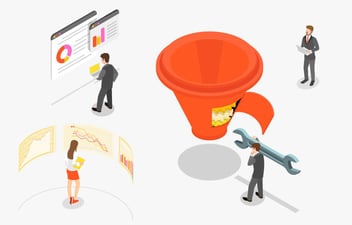Customer profiles are a crucial component of successful inbound marketing. According to HubSpot, customer profiles identify - “purchasing behaviours, pain points, psychographic data, and demographic data with the intent of targeting similar customers in your sales and marketing campaigns.”
In other words, with a good customer profile, your marketing team will know who to market to and your sales team will know who they are selling to.
Profiles remove the guesswork and tighten up your marketing efforts, paving the way for better results.
In this blog post, we’ll look at the role of customer profiles, as well as give you a rundown of 19 questions you need to ask to squeeze the most value from your customer profiles.
Let’s start with some definitions.
What is a B2B Customer Profile?
Customer profiles - which you may also see called buyer personas - are fictional representations of prospective customers of your business.
While fictional, an integral part of customer profiles is that they are as realistic as possible. The best B2B customer profiles are benchmarked against real customer data, ideally current customers.
If you don’t have this, however, educated assumptions and research will suffice.
Customer profiles are living documents: that is, they work best when they’re updated and refined over time. Just as your business grows and changes, so too do the needs of your prospective customers, and even what the industry looks like as a whole.
Revisiting your customer profiles every once in a while will ensure they continue to be as valuable as possible on an ongoing basis.
Why Use B2B Customer Profiles?
Put simply, without a good idea of who you’re directing your marketing efforts to, they’ll probably fall short.
As a basic example, imagine you’re putting out an advert for your SaaS company. There’s no point putting it in a kid’s magazine because there will be zero overlaps between the needs of the person seeing the ad and the service you offer.
Follow that logic and you quickly see the importance of being able to use increasingly granular targeting for your marketing efforts.
Customer profiles are a tool to help you do just that: by drilling deep into the behaviours, pain points and other data relating to your prospective customers, you empower yourself to make more targeted - and more powerful - marketing decisions.
These profiles also control against situations where you’re trying to do too much. No business can perfectly meet the needs of every prospective customer, and trying to do so - intentionally or otherwise - reduces your ability to perform in other areas.
Customer profiles are a powerful way to focus your marketing efforts: to make sure that the decisions you’re making are rooted in reality, rather than in fantasy.

19 Questions to Strengthen Your B2B Customer Profile, and Why You Should Ask Them
When creating customer profiles, tackle them one at a time. Choose a persona you want to target and work through the questions below, giving as much detail as possible.
Also, try to focus on the motives behind the behaviour: it’s here that the real insight sits. The things that will help you to make meaningful alterations to your marketing.
1. What is Their Demographic Information?
Start at the top. Think about information like age, gender, marital status, location, salary, and so on. This helps to paint a broad picture of the person you’re targeting and gives preliminary information that you can build on later.
2. What is Their Educational Background?
Is your prospect college-educated? University? Post-graduate?
Answering this question refines your demographic understanding, and can give clues on where to pitch communications. Content heavy in technical jargon may land better with higher levels of education, for example.
3. What has Their Career Path Been Like?
Has your prospect spent a long time working their way up the industry ladder, or have they recently switched in from another career? Or perhaps they’re just starting their journey?
With this information you can gleam their level of experience with the industry, the trends they may or may not be familiar with, how deep-rooted their assumptions are and so on.
Someone deeply embedded in a decades-long career may be less receptive to newer ideas, for example. Or perhaps they will be aware of some long-established precedent baked into your solutions that would be lost on more recent hires?
4. What is Their Job Title and Seniority Level?
Following on from point 3, specific information on job title and seniority level lets you hone in even further on the prospect’s career position.
Seniority level is a very handy piece of information to have as it ties into decision-making capabilities: if you’re marketing to someone who has the power to make decisions within a company, you can incorporate a more convincing tone into your marketing.
5. What is the Size of Their Company?
Customer profiles work best when they give information about the company as well as the customer. Understanding company size lets you establish which product(s) or service(s) would be suitable: there’s no point promoting a subscription level with 100+ seats to a business with 10 people, for example.
6. Who Do They Report To / Who Reports To Them?
Tying back to 4. where we looked at decision-making, understanding the reporting hierarchy is valuable, too. If your prospect reports to seniors who are only interested in top-level metrics, perhaps letting them know about your bespoke reporting dashboards would be useful.
Alternatively, if they have a lot of people reporting to them, maybe something to summarise and streamline the process would help.
This question further refines your understanding of the solutions you can offer.
7. How is Their Success Measured?
Again, understanding KPIs and metrics that are directly relevant to your prospective customer helps you to strengthen the relevance of recommendations made and information shared.
8. What Does a Typical Day Look Like?
Does your prospect spend all day at a desk, or are they constantly on the go? If the latter, maybe an ebook isn’t the best thing to send - they probably won’t ever get a chance to look at it.
Understanding your prospect’s average schedule helps you to send communications and resources in a format they’re likely to engage with, rather than ones that will languish at the bottom of an inbox.
9. What Knowledge / Skills / Tools Do They Use in Their Role?
What does your prospect’s existing toolkit look like? And, more importantly, how can your offering complement this?
Trying to sell a product or service that they already have isn’t going to go down well. Demonstrating how your product or service fills a gap in their setup, however, might go down a little better. And if you can show that your product or service is better than something they have already? Well, that’s a great conversation starter.
10. What Are Their Biggest Challenges?
Perhaps the most valuable question in the list so far is: what challenges is your prospect facing? And, more importantly, how can you help to solve them?
Earlier we mentioned how important it is to ensure customer profiles are rooted as much as possible in real data. We’d like to emphasise this point again here: asking existing customers which challenges they are (/were) facing is a crucial part of refining your offering and marketing efforts to help prospective customers.
11. What are Their Goals?
Following on from the above, getting a feel for your prospect’s goals to help you to attach an outcome to marketing communications. Demonstrating a clear link between your offering and them solving their problems is a surefire way to catch a prospect’s attention.
Try to be as specific as possible here: clearly define goals, attach metrics where possible.
12. What Are the Major Benefits That Your Customers Get From Your Product or Service?
We’ve touched on it previously, but in this step, we look specifically at the aspects of your product(s) or service(s) that will benefit prospective customers.
This could be broad products or specific features, whichever is most relevant to the understanding you’ve been building to this point.
Being able to demonstrate specific benefits is a way to bring prospects on board, and the more tangible and relatable the better.
13. Where Do They Learn About New Information for Their Job?
Does your prospect spend time reading industry publications? And if so, do they read online or hard copies? Or perhaps they watch videos, listen to podcasts, or even attend networking events?
This information is valuable for a couple of reasons. Firstly, it strengthens your understanding of media type(s) that are likely to resonate. Secondly, it indicates whether certain types of ads are likely to work. There’s no point paying for display ads on an industry blog they’re never going to look at, for example.
This touches on the ability of a well-put-together customer profile to inform all aspects of a marketing campaign.
14. What Publications and/or Blogs Do They Read?
This question aims to tighten up the answer given in the previous one. Try to build a list of specific publications. Then, try to get information about their readership metrics, content offering, and so on.
15. What Associations and Social Networks Are They Part Of?
Similar to 14., here we’re looking for granular information about where your prospect spends time. Think about the intent behind their membership: what are they looking to achieve? Why do they consider membership a worthwhile investment? Is there anything here you can replicate?
16. How Do They Prefer To Interact With Vendors?
We’ve touched on preferred media types a couple of times. It’s worth thinking about preferred interaction types, too. Does your prospect like to pick up the phone for a one-on-one chat? Or do they need a face-to-face meeting with a slick Powerpoint and a handful of stakeholders in attendance?
Knowing this before you begin interacting improves the likelihood of them reciprocating. It saves you wasting time and effort on communication that isn’t going to land.
17. How Do They Research Vendors?
Not all of this goes one way. Sometimes your prospective customers will find you without you having been in touch, and you’ll want to make sure that the information you’re putting out aligns with their preferred way of researching prospects.
Do they want a thorough comparison of different subscriptions you offer, for example? If so, you’ll want to make sure you have this available on your site.
Or do they need to see a long list of testimonials from influential companies before they’ll trust you enough to reach out?
Knowing what your prospect needs to see puts you in better stead to have that information readily available.
18. What Are Their Objections to Purchasing?
Every prospect will have barriers to purchase. Sometimes these will be simple things like cost. Other times it will be some conceptual block: perhaps they can’t visualise how your solution applies to their business.
Refining your understanding of these barriers helps you to overcome them. If cost is an issue, for instance, you could lure them in with a free trial. Or if they can’t visualise the benefits, a guided tour with an agent who can demonstrate specific use cases could be the game-changer.
19. Why Would Your Prospects NOT Buy What You're Offering?
This question aims to clarify insights from the previous two. When the various barriers to purchase have been explored, what factors might still stand in the way of purchase?
You have to be quite searching here, as some of the answers may not reflect too well on your business. Is your offering too expensive? Is there a lack of trust? Dig deep and list as many of these things as possible, then start to think about how you can remove each of these blocks.
Start Building Your Customer Profiles Today
Hopefully, by now it’s clear how powerful customer profiles can be, especially when you invest time and effort into making them as detailed as possible.
If the prospect of creating profiles is daunting, let us give you a hand. We’ve put together a free customer profile template to get you up and running.
With this template, you’ll be able to quickly build out customer profiles to underpin and empower your marketing efforts.




